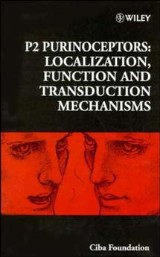Details

P2 Purinoceptors
Localization, Function and Transduction MechanismsNovartis Foundation Symposia, Band 198 1. Aufl.
|
121,99 € |
|
| Verlag: | Wiley |
| Format: | |
| Veröffentl.: | 30.04.2008 |
| ISBN/EAN: | 9780470514917 |
| Sprache: | englisch |
| Anzahl Seiten: | 346 |
DRM-geschütztes eBook, Sie benötigen z.B. Adobe Digital Editions und eine Adobe ID zum Lesen.
Beschreibungen
Many different pathological conditions are currently under investigation as therapeutic targets of purines including cancer, cardiovascular conditions, behavioural disorders, inflammation, immunoregulation, and neuroendocrine function. This book draws together research on all aspects of P2 purinoceptors and discusses their use in different therapeutic areas.
Partial table of contents: <p>P2 Purinoceptors: Historical Perspective and Classification (G. Burnstock).</p> <p>P2T Purinoceptors: ADP Receptors on Platelets (S. Hourani and D. Hall).</p> <p>Trophic Actions of Extracellular ATP on Astrocytes, Synergistic Interactions with Fibroblast Growth Factors and Underlying Signal Transduction Mechanisms (J. Neary).</p> <p>The Diverse Series of Recombinant P2Y Purinoceptors (E. barnard, <i>et al.</i>).</p> <p>Functional Properties of Native and Cloned P2X Receptors (A. Surprenant).</p> <p>Involvement of Distinct Receptors in the Actions of Extracellular Uridine Nucleotides (J. Boeynaems, <i>et al.</i>).</p> <p>Challenges in Developing P2 Purinoceptor-Based Therapeutics (M. Williams).</p> <p>Indexes.</p>
<p><b>Derek J. Chadwick</b> and <b>Jamie A. Goode</b> are editors for <i>P2 Purinoceptors: Localization, Function and Transduction Mechanisms</i> and other scientific titles.</p>
The potent biological actions of the purine nucleotides and nucleosides, adenosine and ATP, have been recognized since 1929, and the clinical effects in humans of administration of ATP have been explored since the 1950s. However, it was not until 1972 that purinergic neurotransmission was proposed, and later, in 1978, the existence of specific receptors for extracellular ATP that recognize the triphosphate nucleotide, but not adenosine, was established. These receptors have been referred to as P2 purinoceptors whereas those responding to adenosine have been termed P1 purinoceptors. Pharmacological evidence has led to further subclassification of receptor types into two major families (the P2X and P2Y types) and several subtypes within these. The P2X receptors are members of the ligand-gated ion channel superfamily whereas the P2Y receptors are seemingly members of the G protein-coupled receptor superfamily. The genes for several P2 receptor subtypes have now been cloned permitting more detailed structural and functional studies. This book covers recent advances in all major aspects of research on P2 purinoceptors. Specific topics include receptor pharmacology, transduction mechanisms, the cloning and expression of genes for the P2 purinoceptor subtypes, and the distribution and biological roles of P2 purinoceptors. The possibilities afforded by P2 purinoceptor ligands as potential therapeutic entities are also discussed.
Diese Produkte könnten Sie auch interessieren:

Zukunftstechnologie Tissue Engineering

von: Will W. Minuth, Raimund Strehl, Karl Schumacher

114,99 €

Zukunftstechnologie Tissue Engineering

von: Will W. Minuth, Raimund Strehl, Karl Schumacher

114,99 €














